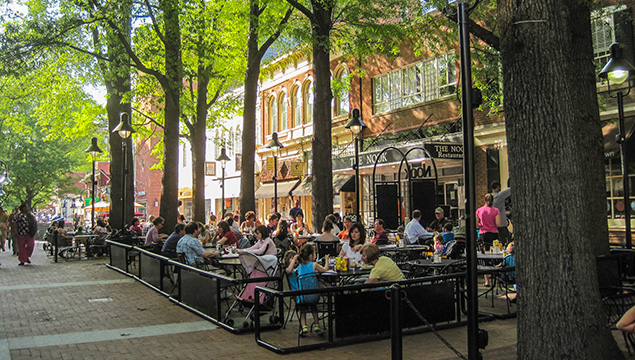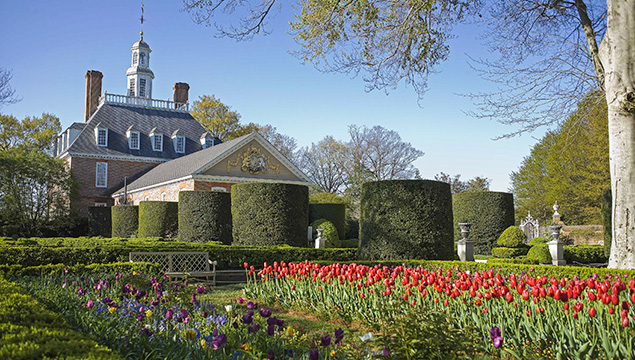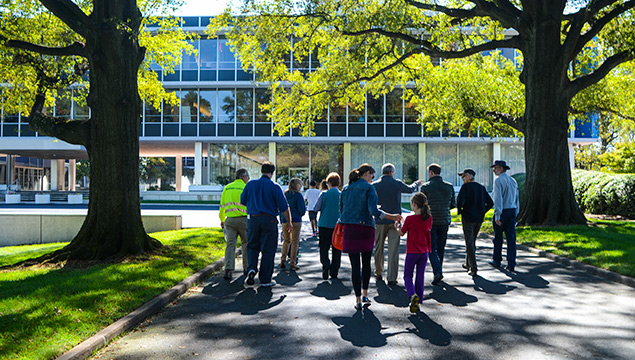Now We Know What’s Out There Virginia

With community input, landscape architect Lawrence Halprin transformed the Charlottesville Mall in the 1970s.Photo © Charles A. Birnbaum
The Cultural Landscape Foundation (TCLF) is proud to announce the completion of the What’s Out There Virginia project, funded by the National Endowment for the Arts (NEA) Art Works program. The initiative commenced in 2013 with the receipt of a $30,000 grant from the NEA. Although the documentation funded by the grant is now complete, TCLF’s activities in Virginia will continue, as many significant works of landscape architecture remain to be documented.
Working with faculty and students in landscape architecture at the University of Virginia and Virginia Polytechnic Institute and State University (Virginia Tech), as well as affiliated non-profit organizations and federal, state, and municipal agencies, TCLF documented more than 100 nationally significant landscapes in the Commonwealth of Virginia. The University of Virginia and Virginia Tech were both involved from the inception of the project through its completion. The faculty advisors for each of these institutions— Elizabeth Meyer at the University of Virginia and Brian Katen and Terry Clements at Virginia Tech—worked with a number of students who contributed to the What's Out There Virginia program. Students who interned with the program developed research skills and honed their abilities to document the complex histories of landscape design while also gaining a stronger appreciation for the interconnectedness of landscapes in Virginia and the United States.
Explore the What's Out There Virginia database.
Included in the research were historic sites, vernacular landscapes, and designed spaces in both urban and rural locations. Students conducted field work and archival research to assess the conditions of each landscape, created digital photographs of the sites and surrounding contexts, and developed 250-word essays about the history, design, and integrity of the landscapes. Students also wrote essays about the landscape architects and planners involved in the creation, development, and stewardship of the sites. The photographs and essays were submitted to TCLF for posting to the What's Out There database, which today comprises some 1,900 individual entries. The project has produced illustrated essays about a diversity of landscapes in Virginia, including plantations, Civil War battlefields, state parks, cemeteries, estate gardens, university campuses, public parks, civic plazas, park systems, parkways and scenic byways, pedestrian malls, memorials and commemorative landscapes, Civilian Conservation Corps projects, and others. Through the research conducted in Virginia, where a proliferation of Colonial Revival sites exist, TCLF was able to broaden its understanding of that style and make substantial revisions to its glossary definition.

Gardens at the Governor’s Palace were envisioned by Arthur Shurcliff, 1928-1941. Photo courtesy the Colonial Williamsburg Foundation
By 2014, TCLF had generated enough documentation to develop a two-day event featuring free, expert-led tours of landscapes in Virginia's capital city of Richmond. Working with the aforementioned academic partners as well as Richmond-based site managers, non-profit advocacy and stewardship organizations, and municipal agencies, TCLF organized 30 free, expert-led tours attended by the public. Accompanying these tours, a guidebook of the sites was produced. Available in printed and digital formats, the guidebook includes a map, an overarching essay about the history of Richmond's parks and open spaces, a discussion about the importance of the Colonial Revival style to Virginia's landscapes, and essays about each of the sites. TCLF worked closely with the Lewis Ginter Botanical Garden, the Virginia Chapter of the American Society of Landscape Architects, the City of Richmond, the Sara Shallenberger Brown Cultural Landscape Initiative, and the Valentine History Center in the selection of tour sites and the presentation of the tours. What's Out There Weekend Richmond attendees learned about historic events and design trends that shaped their city. The breadth of landscapes in Richmond included historic Civil War era sites (White House of the Confederacy, Chimborazo Park and Medical Museum, and Tredegar Iron Works), institutional grounds (Capitol Square, Reveille United Methodist Church and Garth, Virginia Museum of Fine Arts, the Edgar Allen Poe Museum), commemorative landscapes (Hollywood Cemetery, Virginia War Memorial), estate gardens (Maymont, Rice House), and public parks (James River Park System, Monroe Park, Libby Hill). This diversity attracted a wide audience, exposing them to the language of landscape architecture and encouraging them to promote stewardship of these sites. TCLF is already making plans to coordinate a similar undertaking in Charlottesville, Virginia.

Tour attendees visit Altria Headquarters as part of What’s Out There Weekend Richmond. Photo © Matthew Traucht
Through its partnerships with the University of Virginia and Virginia Tech, TCLF has developed a robust university partnership program: Inspired by the successful partnerships with these institutions, TCLF has engaged with academic partners in Texas, Colorado, Louisiana, and Toronto for similar research projects. The partnerships in Virginia also became the basis for a paper that was accepted by the Council of Educators in Landscape Architecture (CELA) and presented by What's Out There program manager Matthew Traucht at CELA's 2015 conference in Manhattan, Kansas. Traucht delivered a similar presentation to professional landscape architects at the Virginia Chapter of the American Society of Landscape Architects' annual conference in Charlottesville in March 2015.
Upon the project's completion, the initiative has exceeded its original goals of adding 100 landscapes to the What's Out There database. For some sites not yet in the database, essays and photos that have been submitted are in the final stages of editing and will be posted soon. Moreover, the partnerships created through this project will continue and submissions to the database will increase. Through the funding provided by the NEA and the contributions of the project partners, this grant has enabled TCLF to make Virginia's landscape legacy visible to the general public, which will in turn promote the stewardship of these places. If you know of a site in Virginia—or anywhere—that should be added to TCLF's database, send an email and help us discover what's out there.



